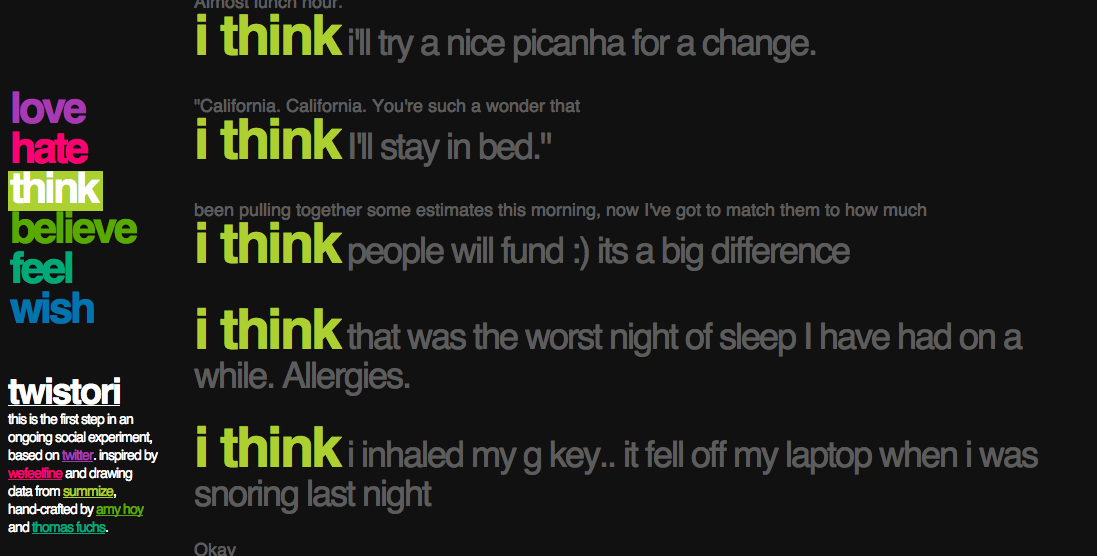Stephen Davies at PR Blogger is turning into a one man Twitter PR resource at the moment. And perhaps providing a useful case study in open source PR.
Last Friday, he posted his initial list of UK journalists on Twitter – thus sparking a healthy dose of comments from both PRs and hacks. Including some very useful tips for PRs in terms of how best to work with journalists on Twitter (see below).
And now Andrew Girdwood from Bigmouthmedia (the guys behind the 79 out of top 100 UK PR agencies don’t offer online services survey) has created an RSS feed that amalgamates all the public Tweets from Stephen’s list of UK journalists. As Andrew points out, having this kind of RSS feed is useful because: “you want to see what these journalists are tweeting just in case you’ve got a useful response handy, but you may also want to avoid adding dozens of people you don’t know very well to your Twitter follow list. It’s also possible that journalists don’t fancy having a bunch of strangers all rock up as brand new Twitter followers.”
And if that wasn’t enough, Stephen has now released a list of UK PR people on Twitter.
That’s a lot of useful PR innovation in the space of three days (two of which were a Saturday and Sunday).
Free and openly available PR resources that once made available inspire others to create other useful tools. If that can be achieved in three days, what can we expect in a week or a month’s time? Now that’s what I call the power of open source PR.
Journalist tips for PRs on using Twitter
Kat Hannaford at T3: (likes frozen peas, the Smiths, and ketjap manis sauce)
“I’ve got to say on the whole, I don’t mind too much when PRs follow me on Twitter – particularly if
-I know them
-if they are at an agency I’m aware of
-have clients who are relevant to what I write about.
As I only have limited time, and am trying to trim Twitter down a little, I only follow PRs back if at least two of those boxes are checked. And of course, a proper Twitter dialogue (and relationship) can only proceed if both parties follow one another – in which case, it just turns into me being unaware of your brand, and you peeking at 140-word descriptions of my private life.
I’ve had a couple of bad experiences on Twitter with PRs (people trying to push their releases onto me, people spamming me every ten minutes with their @replies and so on), but the worst experiences have actually been with other journalists – who generally don’t seem to understand Twitter (and its benefits) as most PRs, and spend their time peddling links to their dry-as-stale-bread posts. And arguing with me. And pleading for freelance from me. And generally being knobs.”
Linda Jones, Passionate Media:
“I don’t mind if PR people want to follow me on Twitter, and I am keen to hear from them IF they have relevant information that could be helpful in my work, I put together a list of current projects and have tweeted a link to it. I hope this may be useful for me in that I need to find case studies, expert comment and news of relevant organisations etc and I am looking in lots of other places apart from from PR people.
I can’t see that there would be any difference contacting me or ‘pitching’ me by Twitter as from any other means. So long as it’s done well then that’s okay. If you are a PR person following me on Twitter (and a few have signed up since reading this post) please take the time to find out about the work I do before you get in touch by Twitter or any other means.
If you feel that work by any of your clients could genuinely fit with what I’m writing about then please get in touch. Ultimately, for me, it’s not the means of keeping in touch that matters but the story. Don’t push me on stuff you have tweeted to all and sundry but please do think about if there’s anything specific that may be of interest according to the list of current projects I have gone to the trouble of preparing.”


